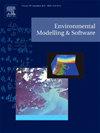机器学习驱动的东地中海PM2.5浓度区域预测弥合空气质量监测的空间数据差距
IF 4.6
2区 环境科学与生态学
Q1 COMPUTER SCIENCE, INTERDISCIPLINARY APPLICATIONS
引用次数: 0
摘要
细颗粒物(PM2.5)由于能够深入呼吸系统而构成重大风险。本研究介绍了区域PM2.5预测器(RPP),这是一个基于机器学习的框架,旨在估计整个土耳其的PM2.5浓度,特别是在PM2.5监测基础设施有限的地区。利用卫星衍生的气溶胶光学厚度(AOT)数据、ERA-5的气象变量和地面空气质量测量数据,该模型集成了2018年至2023年的各种数据集,RPP采用XGBoost算法来解决空间监测空白。该模型在多个评价情景下均具有较强的预测能力:季节分析的RMSE值为4.39 ~ 10.01 μg/m3, R2值为0.66 ~ 0.84;时间评价平均RMSE为8.28 μg/m3, R2为0.76;空间(站盲)交叉验证预测结果可靠,平均RMSE为9.21 μg/m3, R2为0.71;随机抽样的RMSE为6.82 μg/m3, R2为0.85,分割率为80-20%。该框架成功捕获了土耳其的空气质量趋势,PM2.5水平从25.52 μg/m3(2018年)降至18.88 μg/m3(2023年),同时确定了不同地形区域的性能变化。该模型在2019冠状病毒病大流行期间表现出显著的稳定性,在2020年达到最佳性能(RMSE: 7.54 μg/m3, R2: 0.80)。这种方法展示了机器学习如何补充传统的监测网络,为公共卫生干预和环境政策评估提供具有成本效益的空气质量评估。本文章由计算机程序翻译,如有差异,请以英文原文为准。

Machine learning-driven regional prediction of PM2.5 concentrations in the eastern mediterranean bridging spatial data gaps in air quality monitoring
Fine particulate matter (PM2.5) posing significant risks due to its ability to penetrate deep into the respiratory system. This study introduces the Regional PM2.5 Predictor (RPP), a machine learning-based framework designed to estimate PM2.5 concentrations across Turkiye, especially in regions with limited PM2.5 monitoring infrastructure. Leveraging satellite-derived Aerosol Optical Thickness (AOT) data, meteorological variables from ERA-5, and ground-based air quality measurements, the model integrates diverse datasets spanning 2018 to 2023, the RPP employs XGBoost algorithms to address spatial monitoring gaps. The model demonstrates strong predictive performance across multiple evaluation scenarios: the seasonal analysis yielded RMSE values of 4.39–10.01 μg/m3 and R2 values of 0.66–0.84; temporal evaluations achieved an average RMSE of 8.28 μg/m3 and R2 of 0.76; spatial (station-blinded) cross-validation maintained reliable predictions with average RMSE of 9.21 μg/m3 and R2 of 0.71; while random sampling achieved RMSE of 6.82 μg/m3 and R2 of 0.85 with an 80-20 % split. The framework successfully captured Turkiye's air quality trend, with PM2.5 levels decreasing from 25.52 μg/m3 (2018) to 18.88 μg/m3 (2023), while identifying performance variations across diverse topographical regions. The model demonstrated remarkable stability during the COVID-19 pandemic period, achieving its best performance in 2020 (RMSE: 7.54 μg/m3, R2: 0.80). This approach demonstrates how machine learning can complement traditional monitoring networks, providing cost-effective air quality assessments for public health interventions and environmental policy evaluation.
求助全文
通过发布文献求助,成功后即可免费获取论文全文。
去求助
来源期刊

Environmental Modelling & Software
工程技术-工程:环境
CiteScore
9.30
自引率
8.20%
发文量
241
审稿时长
60 days
期刊介绍:
Environmental Modelling & Software publishes contributions, in the form of research articles, reviews and short communications, on recent advances in environmental modelling and/or software. The aim is to improve our capacity to represent, understand, predict or manage the behaviour of environmental systems at all practical scales, and to communicate those improvements to a wide scientific and professional audience.
 求助内容:
求助内容: 应助结果提醒方式:
应助结果提醒方式:


